Yamaha RAPTOR 50 Manual

READ THIS MANUAL CAREFULLY!
It contains important safety information.
OWNER’S MANUAL
YFM50RW
WARNING |
This ATV should not be ridden by anyone under 6 years of age. |
LIT-11626-20-27 |
5YF-28199-14 |
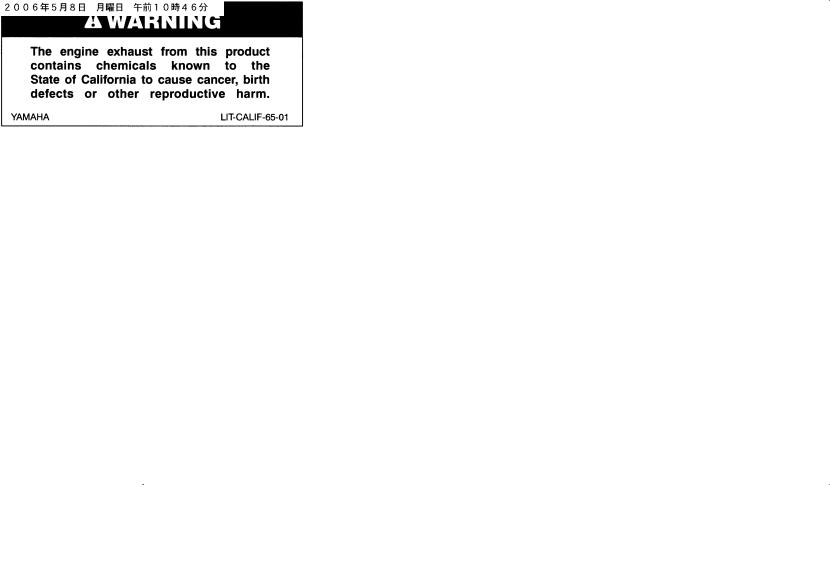
EBU17091

EBU17170
INTRODUCTION
EBU17180
Congratulations on your purchase of the Yamaha YFM50RW. This ATV represents the result of many years of Yamaha experience in the production of fine sporting, touring, and pacesetting racing machines. With the purchase of this Yamaha, you can now appreciate the high degree of craftsmanship and reliability that have made Yamaha a leader in these fields.
This manual will provide you with a good basic understanding of the features and operation of this ATV.
This manual includes important safety information. It provides information about special techniques and skills necessary to ride the ATV. It also includes basic maintenance and inspection procedures. If you have any questions regarding the operation or maintenance of your ATV, please consult a Yamaha dealer.
AN IMPORTANT SAFETY MESSAGE:
●READ THIS MANUAL TOGETHER WITH TIPS FOR THE ATV RIDER CAREFULLY AND COMPLETELY BEFORE OPERATING YOUR ATV. MAKE SURE YOU UNDERSTAND ALL INSTRUCTIONS.
●PAY CLOSE ATTENTION TO THE WARNING AND CAUTION LABELS ON THE ATV.
●NEVER OPERATE AN ATV WITHOUT PROPER TRAINING OR INSTRUCTION. FREE TRAINING IS AVAILABLE TO ANYONE WHO BUYS A NEW ATV. CALL 1-800-887-2887 FOR MORE INFORMATION.
●THIS ATV, AND ANY OTHER ATV OVER 50 cc, SHOULD NOT BE OPERATED BY A CHILD UNDER 6 YEARS OF AGE.
AN IMPORTANT NOTE TO PARENTS:
This ATV is not a toy. Before you let your child ride this ATV, you should understand the instructions and warnings in this Owner’s Manual. Then be sure your child understands and will follow them. Children differ

in skills, physical abilities and judgment. Some children may not be able to operate an ATV safely. Parents should supervise their child’s use of the ATV at all times. Parents should permit continued use only if they determine that the child has the ability to operate the ATV safely.
Your ATV was delivered with an adjustable speed limiter. Yamaha recommends that all beginners start off with the speed limiter screw turned in to limit the amount of speed available while they learn. The speed limiter screw may be gradually turned out to increase maximum speed as the beginner becomes more familiar with operating the ATV.
If your child is a beginner or is inexperienced, he or she should take a training course. See the previous page for information about the free training available to purchasers of new ATVs.
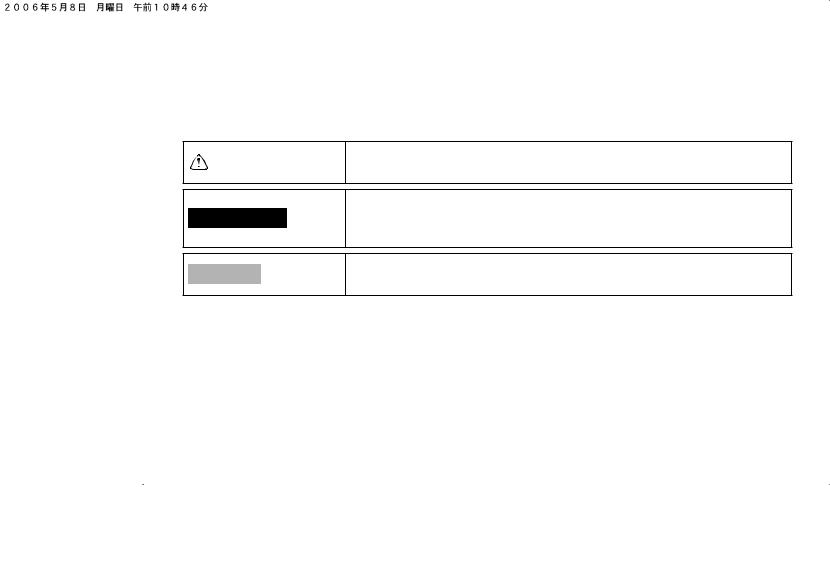
EBU17330
IMPORTANT MANUAL INFORMATION
EBU17341
FAILURE TO FOLLOW THE WARNINGS CONTAINED IN THIS MANUAL CAN RESULT IN SERIOUS INJURY OR DEATH.
Particularly important information is distinguished in this manual by the following notations:
The Safety Alert Symbol means ATTENTION! BECOME ALERT! YOUR
SAFETY IS INVOLVED!
Failure to follow WARNING instructions could result in severe injury  WARNING or death to the ATV operator, a bystander, or a person inspecting or
WARNING or death to the ATV operator, a bystander, or a person inspecting or
repairing the ATV.
CAUTION:
A CAUTION indicates special precautions that must be taken to avoid damage to the ATV.
|
|
|
|
|
NOTE: |
|
A NOTE provides key information to make procedures easier or clearer. |
|
|
|
|
|
|
|
|
* Product and specifications are subject to change without notice.

EBU17350
IMPORTANT NOTICE
EBU17360
Welcome to the Yamaha world of motor sports!
This ATV is designed and manufactured for OFF-ROAD use only. It is illegal and unsafe to operate this ATV on any public street, road or highway.
This ATV complies with all applicable OFF-ROAD noise level and spark arrester laws and regulations in effect at the time of manufacture.
Please check your local riding laws and regulations before operating this ATV.
EBU17381
YFM50RW
OWNER’S MANUAL
©2006 by Yamaha Motor Corporation, U.S.A.
AFFIX DEALER
1st edition, April 2006 All rights reserved.
Any reprinting or unauthorized use LABEL HERE without the written permission of
Yamaha Motor Corporation, U.S.A. is expressly prohibited.
Printed in Japan.
P/N LIT-11626-20-27

EWB00010
 WARNING
WARNING
Indicates a potential hazard that could result in serious injury or death.
EBU17420
TABLE OF CONTENTS
SAFETY INFORMATION .............................. |
1-1 |
LOCATION OF THE WARNING AND |
|
SPECIFICATION LABELS ............................ |
2-1 |
DESCRIPTION .............................................. |
3-1 |
Left view ..................................................... |
3-1 |
Right view................................................... |
3-1 |
Controls and instruments ........................... |
3-2 |
INSTRUMENT AND CONTROL |
|
FUNCTIONS .................................................. |
4-1 |
Main switch ............................................... |
4-1 |
Indicator light ............................................. |
4-2 |
Handlebar switches ................................... |
4-2 |
Engine stop switch with lanyard ................ |
4-3 |
Throttle lever ............................................. |
4-5 |
Speed limiter .............................................. |
4-5 |
Front brake lever ........................................ |
4-6 |
Rear brake lever ........................................ |
4-7 |
Parking brake ............................................. |
4-7 |
Drive select lever ....................................... |
4-8 |
Fuel tank cap ............................................. |
4-9 |
Fuel ............................................................ |
4-9 |
Fuel cock ................................................. |
4-11 |
Choke ...................................................... |
4-12 |
Seat ......................................................... |
4-13 |
PRE-OPERATION CHECKS .......................... |
5-1 |
Pre-operation check list ............................. |
5-1 |
Fuel ............................................................ |
5-3 |
Engine oil ................................................... |
5-3 |
Final gear oil .............................................. |
5-3 |
Front and rear brakes ................................ |
5-3 |
Throttle lever .............................................. |
5-4 |
Tires ........................................................... |
5-4 |
Measuring the tire pressure ....................... |
5-5 |
Tire wear limit ............................................ |
5-6 |
Chassis fasteners ...................................... |
5-7 |
Instruments, lights and switches ................ |
5-7 |
Battery ....................................................... |
5-7 |
OPERATION................................................... |
6-1 |
Starting a cold engine ................................ |
6-1 |
Starting a warm engine .............................. |
6-3 |
Shifting ....................................................... |
6-3 |

Engine break-in ......................................... |
6-5 |
Parking ...................................................... |
6-5 |
Parking on a slope .................................... |
6-6 |
Accessories and loading ........................... |
6-7 |
RIDING YOUR ATV ...................................... |
7-1 |
GETTING TO KNOW YOUR ATV.............. |
7-2 |
RIDE WITH CARE AND GOOD |
|
JUDGEMENT ........................................... |
7-2 |
BE CAREFUL WHERE YOU RIDE.......... |
7-11 |
TURNING YOUR ATV ............................. |
7-15 |
CLIMBING UPHILL .................................. |
7-17 |
RIDING DOWNHILL................................. |
7-20 |
CROSSING A SLOPE.............................. |
7-21 |
CROSSING THROUGH SHALLOW |
|
WATER .................................................. |
7-22 |
RIDING OVER ROUGH TERRAIN .......... |
7-24 |
SLIDING AND SKIDDING........................ |
7-25 |
WHAT TO DO IF... ................................... |
7-26 |
WHAT TO DO... ....................................... |
7-26 |
PERIODIC MAINTENANCE AND MINOR |
|
REPAIR .......................................................... |
8-1 |
Owner’s manual and tool kit ...................... |
8-1 |
Periodic maintenance chart for the |
|
emission control system .......................... |
8-3 |
General maintenance and lubrication |
|
chart ........................................................ |
8-5 |
Checking the spark plug ............................ |
8-8 |
Engine oil ................................................. |
8-10 |
Final gear oil ............................................ |
8-13 |
Cleaning the air filter element .................. |
8-14 |
Cleaning the spark arrester ..................... |
8-17 |
Adjusting the carburetor ........................... |
8-19 |
Adjusting the engine idling speed ............ |
8-19 |
Checking the throttle cable free play ....... |
8-20 |
Valve clearance ....................................... |
8-20 |
Checking the front and rear brake |
|
shoes ..................................................... |
8-21 |
Adjusting the front brake lever free |
|
play ........................................................ |
8-22 |
Adjusting the rear brake lever free |
|
play ........................................................ |
8-24 |
Checking and lubricating the cables ........ |
8-25 |
Checking and lubricating the front and |
|
rear brake levers .................................... |
8-26 |
Checking the wheel bearings ................... |
8-26 |
Lubricating the knuckle shafts ................. |
8-26 |
Lubricating the steering shaft ................... |
8-27 |
Battery ..................................................... |
8-27 |
Replacing the fuse ................................... |
8-30 |
Removing a wheel ................................... |
8-31 |
Installing a wheel ..................................... |
8-32 |
Troubleshooting ....................................... |
8-33 |
Troubleshooting chart .............................. |
8-35 |
CLEANING AND STORAGE .......................... |
9-1 |
Cleaning ..................................................... |
9-1 |

Storage ...................................................... |
9-2 |
SPECIFICATIONS ...................................... |
10-1 |
CONSUMER INFORMATION ...................... |
11-1 |
Identification numbers ............................. |
11-1 |
Noise regulation ...................................... |
11-3 |
Maintenance record ................................ |
11-3 |
YAMAHA MOTOR CORPORATION, |
|
U.S.A. ATV LIMITED WARRANTY ....... |
11-5 |
YAMAHA EXTENDED SERVICE |
|
(Y.E.S.) .................................................. |
11-7 |

EBU17430
1
 SAFETY INFORMATION
SAFETY INFORMATION
EBU17631
AN ATV IS NOT A TOY AND CAN BE HAZARDOUS TO OPERATE. An ATV handles differently from other vehicles, including motorcycles and cars. A collision or rollover can occur quickly, even during routine maneuvers such as turning and riding on hills or over obstacles, if you fail to take proper precautions.
SEVERE INJURY OR DEATH can result if you do not follow these instructions:
●Read this manual and all labels carefully and follow the operating procedures described.
●Never operate an ATV without proper training or instruction. Take a Training Course. Beginners should receive training from a certified instructor. Contact an authorized ATV dealer or call 1- 800-887-2887 to find out about the training courses nearest you.
●Always follow the age recommendation:
– A child under 6 years old should never operate
an ATV with engine size greater than 50 cc.
–A child under 12 years old should never operate an ATV with engine size greater than 70 cc.
–A child under 16 years old should never operate an ATV with engine size greater than 90 cc.
●Never allow a child under age 16 to operate an ATV without adult supervision, and never allow continued use of an ATV by a child if he or she does not have the abilities to operate it safely.
●Never carry a passenger on an ATV.
●Always avoid operating an ATV on any paved surfaces, including sidewalks, driveways, parking lots and streets.
●Never operate an ATV on any public street, road or highway, even a dirt or gravel one.
●Never operate an ATV without wearing an approved motorcycle helmet that fits properly. You should also wear eye protection (goggles or face shield), gloves, boots, a long-sleeved shirt or a jacket, and long pants.
●Never consume alcohol or drugs before or while
1-1

operating this ATV. |
speeds and never turn at excessive speeds. |
||
● Never operate at speeds too fast for your skills |
● Never operate the ATV on hills too steep for the |
|
|
1 |
|||
or the riding conditions. Always go at a speed |
ATV or for your abilities. Practice on smaller hills |
||
that is proper for the terrain, visibility, operating |
before attempting larger hills. |
|
|
conditions, and your experience. |
● Always follow proper procedures for climbing |
||
● Never attempt wheelies, jumps, or other stunts. |
hills as described in this manual. Check the ter- |
||
● Always inspect your ATV each time you use it to |
rain carefully before you start up any hill. Never |
||
make sure it is in safe operating condition. Al- |
climb hills with excessively slippery or loose sur- |
||
ways follow the inspection and maintenance |
faces. Shift your weight forward. Never open the |
||
procedures and schedules described in this |
throttle suddenly or make sudden gear changes. |
||
manual. |
Never go over the top of a hill at high speed. |
||
● Always keep both hands on the handlebars and |
● Always follow proper procedures for going down |
||
both feet on the footrests of the ATV during op- |
hills and for braking on hills as described in this |
||
eration. |
manual. Check the terrain carefully before you |
||
● Always go slowly and be extra careful when op- |
start down any hill. Shift your weight backward. |
||
erating on unfamiliar terrain. Always be alert to |
Never go down a hill at high speed. Avoid going |
||
changing terrain conditions when operating the |
down a hill at an angle that would cause the ve- |
||
ATV. |
hicle to lean sharply to one side. Go straight |
||
● Never operate on excessively rough, slippery or |
down the hill where possible. |
||
loose terrain until you have learned and prac- |
● Always follow proper procedures for crossing |
||
ticed the skills necessary to control the ATV on |
the side of a hill as described in this manual. |
||
such terrain. Always be especially cautious on |
Avoid hills with excessively slippery or loose sur- |
||
these kinds of terrain. |
faces. Shift your weight to the uphill side of the |
||
● Always follow proper procedures for turning as |
ATV. Never attempt to turn the ATV around on |
||
described in this manual. Practice turning at low |
any hill until you have mastered the turning tech- |
||
speeds before attempting to turn at faster |
nique described in this manual on level ground. |
||
1-2

Avoid crossing the side of a steep hill if possible.
●Always use proper procedures if you stall or roll
1backwards when climbing a hill. If you stall or roll backwards, follow the special procedure for braking described in this manual. Apply the front brake or dismount on the uphill side or to a side if pointed straight uphill. Turn the ATV around and remount, following the procedure described in this manual.
●Always check for obstacles before operating in a new area.
●Never attempt to operate over large obstacles, such as large rocks or fallen trees. Always follow proper procedures when operating over obstacles as described in this manual.
●Always be careful when skidding or sliding. Learn to safely control skidding or sliding by practicing at low speeds and on level, smooth terrain. On extremely slippery surfaces, such as ice, go slowly and be very cautious in order to reduce the chance of skidding or sliding out of control.
●Never operate an ATV in fast flowing water or in water deeper than that recommended in this manual. Remember that wet brakes may have reduced stopping ability. Test your brakes after
leaving water. If necessary, apply them several times to let friction dry out the linings.
●Always use the size and type of tires specified in this manual.
●Always maintain proper tire pressure as described in this manual.
●Never modify an ATV through improper installation or use of accessories.
●Never exceed the stated load capacity for an ATV. Cargo should be properly distributed and securely attached. Reduce speed and follow instructions in this manual for carrying cargo or pulling a trailer. Allow greater distance for braking.
FOR MORE INFORMATION ABOUT ATV SAFETY, call the Consumer Products Safety Commission at 1-800-638-2772, or the ATV Distributor’s Safety Hotline at 1-800-852-5344.
1-3
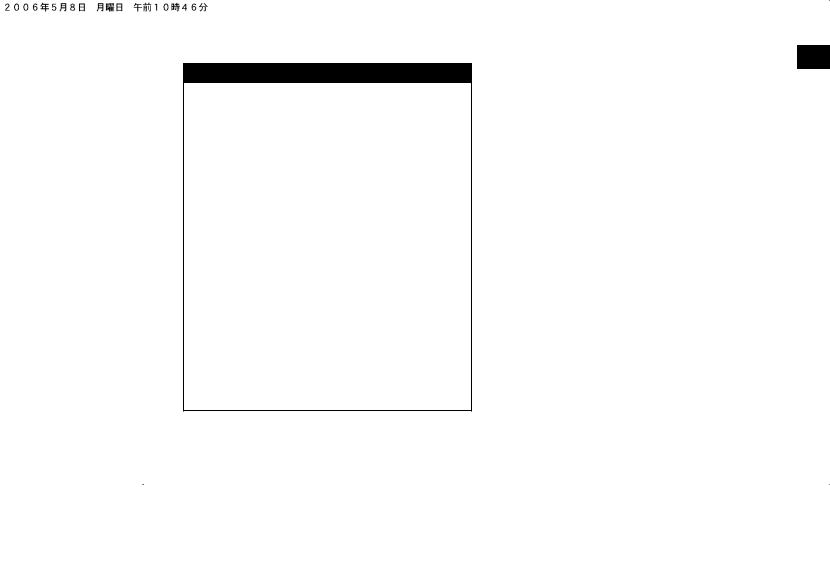
TEACHING YOUR CHILD TO OPERATE THE ATV
EWB00040
 WARNING
WARNING
POTENTIAL HAZARD
Allowing a child under 16 to operate this ATV without adult supervision (a child under 6 should not ride this ATV even with adult supervision).
WHAT CAN HAPPEN
If the child rides beyond his or her abilities, or rides in terrain that is too difficult, he or she may lose control of the ATV, causing an accident.
HOW TO AVOID THE HAZARD
Never let your child ride an ATV without close adult supervision. Promptly correct your child if he or she begins to ride beyond his or her abilities and, if necessary, intervene by pulling the cord (lanyard) to stop the engine.
Introduce new riding areas slowly and make sure the riding area matches your child’s skill level.
You must make the commitment to your child’s proper use of the ATV. Your child must rely upon
you to be sure he or she has the development, proper training, and proper equipment, as well as
an appropriately sized ATV and an appropriate 1 riding area.
Be sure your child is ready to learn how to ride
As a parent, your first step is to decide when your child has the strength, skills, and judgment to learn how to operate an ATV safely. To help you make that decision, the ATV Safety Institute publishes a readiness checklist. It is printed in the Parents, Youngsters and ATVs booklet that was included with your ATV when newly purchased. You can also review the checklist on the Internet at www.atvsafety.org. Re-evaluate your child’s readiness before every use; a child who is too tired or distracted should not be allowed to operate the ATV.
Be sure your child is properly trained
Your child should take a certified training course, like the ATV RiderCourse® offered by the ATV Safety Institute. Call ATV Enrollment Express tollfree at 1-800-887-2887 for more information. Training will continue with you as the instructor, so you should be sure you thoroughly understand proper riding techniques before continuing to in-
1-4

struct your child. Go through this Owner’s Manual and the Parents, Youngsters and ATVs booklet
1page by page with your child and be sure he or she understands how to operate the ATV properly.
Be sure your child is wearing all the proper safety equipment
Your child must always wear an approved motorcycle helmet that fits properly. Your child should also wear the safety equipment described in the Riding Your ATV section of this manual.
Choose an appropriate riding area
Select an area appropriate for your child to learn to ride. (See page 7-11.) Follow the instructions in the Riding Your ATV section of this manual. Choose a large, flat off-road area that is free of obstacles and away from other vehicles.
Supervise every use of the ATV
Because an adult must supervise every ATV operator under age 16, you should closely watch your child every time he or she uses the ATV. Be ready to intervene immediately if the child is not operating according to your guidelines. This ATV is fitted with an engine stop switch cord (lanyard) device that will let you stop the engine remotely as you
walk behind the vehicle.
ENGINE STOP SWITCH CORD
This model has an engine stop switch cord (lanyard) designed for use by an adult supervising the child operating the ATV. When using the engine stop switch cord, be sure the speed limiter on the handlebar is adjusted to limit the ATV to a walking speed. (See page 4-5.)
1.Push the clip on the end of the engine stop switch cord under the engine shut-off switch (black button).
2.Put your fingers in the loop at the other end of the cord.
3.As your child is riding, walk behind the ATV, closely watching his or her actions as well as the path ahead.
4.If there is a potential hazard ahead or if your child is not riding correctly, pull firmly on the cord to stop the engine. Because the ATV will continue to roll for some distance, allow extra time and distance to pull the cord before a potentially hazardous situation might be encountered.
When your child has developed sufficient skill to no longer need you to follow with the cord, the cord can be stowed under the seat of the ATV. Howev-
1-5
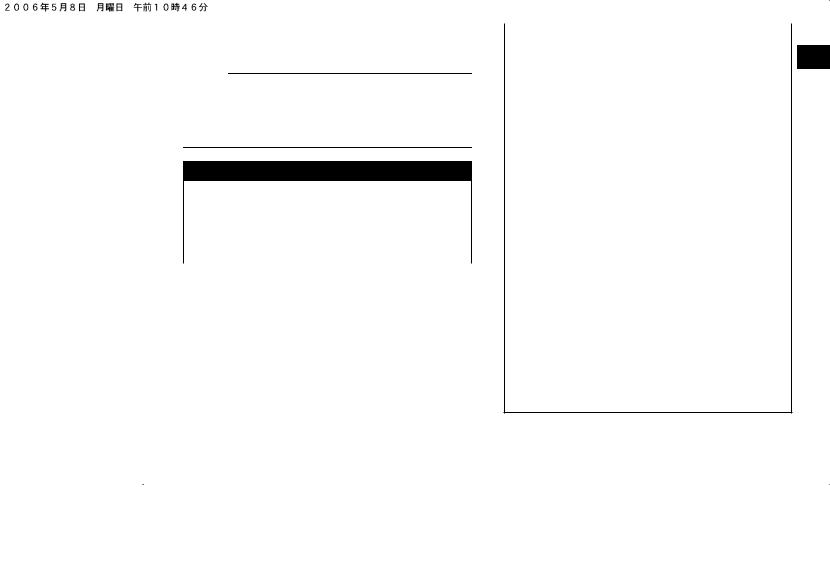
er, you must still closely supervise your child at all times during ATV operation.
NOTE:
The ATV will not start without the clip in place. Be sure to remove the cord and store it in a safe place to prevent operation of the ATV when you are not around to supervise.
EWB00021
 WARNING
WARNING
POTENTIAL HAZARD Improper handling of gasoline. WHAT CAN HAPPEN
Gasoline can catch fire and you could be burned.
HOW TO AVOID THE HAZARD
Always turn off the engine when refueling.
Do not refuel right after the engine has been 1 running and is still very hot.
Do not spill gasoline on the engine or exhaust pipe/muffler when refueling.
Never refuel while smoking, or in the vicinity of sparks, open flames, or other sources of ignition such as the pilot lights of water heaters and clothes dryers.
When transporting the ATV in another vehicle, be sure it is kept upright and that the fuel cock is in the “OFF” position. Otherwise, fuel may leak out of the carburetor or fuel tank.
WHAT CAN HAPPEN
Gasoline is poisonous and can cause injuries.
HOW TO AVOID THE HAZARD
If you should swallow some gasoline or inhale a lot of gasoline vapor, or get some gasoline in your eyes, seek medical help immediately. If gasoline spills on your skin, wash with soap and water. If gasoline spills on your clothing, change your clothes.
1-6

|
HOW TO AVOID THE HAZARD |
|
1 |
Always operate your ATV in an area with ad- |
|
equate ventilation. |
||
|
EWB00030
 WARNING
WARNING
POTENTIAL HAZARD
Starting or running the engine in a closed area.
WHAT CAN HAPPEN
Exhaust fumes are poisonous and may cause loss of consciousness and death within a short time.
1-7
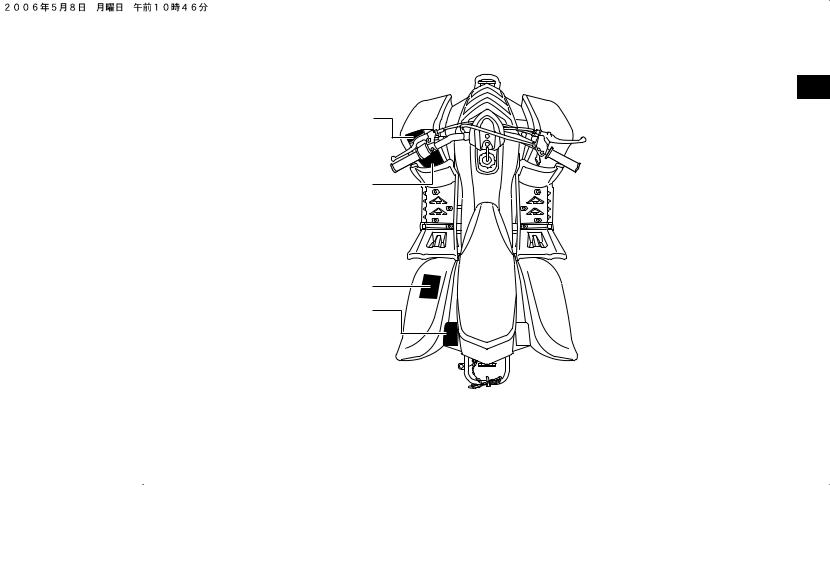
EBU17660
LOCATION OF THE WARNING AND SPECIFICATION LABELS
2
1
2
3
4
2-1

EBU17670
Read and understand all of the labels on your ATV. These labels contain important information for safe and proper operation.
2Never remove any labels from your ATV. If a label becomes difficult to read or comes off, request a replacement label from your Yamaha dealer.
2-2
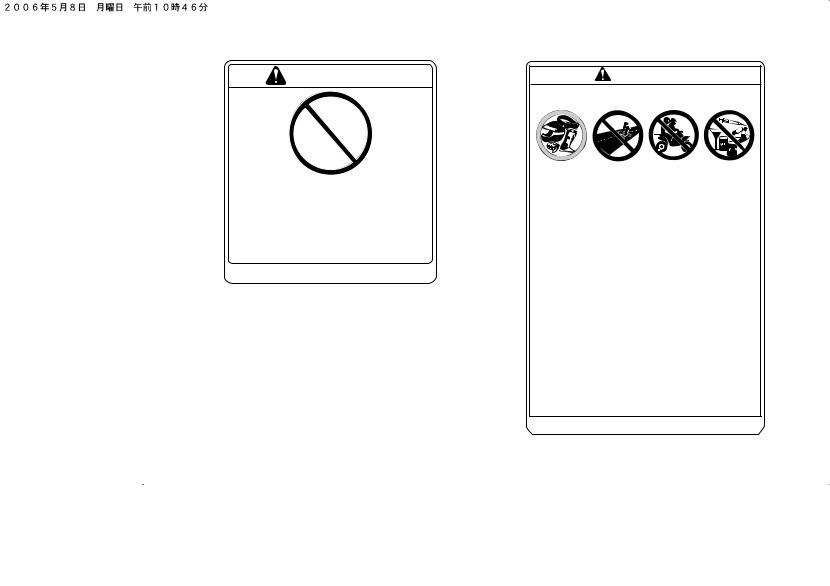
1
WARNING
UNDER
6
Operating this ATV if you are under the age of 6 increases your chance of severe injury or death.
Adult supervision required for children under age 16.
NEVER permit children under age 6 to operate this ATV.
5YF-21697-00
2 |
WARNING |
|
|
2 |
|
|
Improper ATV use can result in SEVERE |
|
|
|
|
|
INJURY or DEATH. |
|
ALWAYS USE |
NEVER USE |
NEVER CARRY |
NEVER USE |
AN APPROVED |
ON PUBLIC |
PASSENGERS |
WITH DRUGS |
HELMET AND |
ROADS |
|
OR ALCOHOL |
PROTECTIVE |
|
|
|
GEAR |
|
|
|
NEVER operate :
 without proper training or instruction.
without proper training or instruction.
 at speeds too fast for your skills or the conditions.
at speeds too fast for your skills or the conditions.
 on public roads-a collision can occur with another vehicle.
on public roads-a collision can occur with another vehicle.
 with a passenger-passengers affect balance and steering and increase risk
with a passenger-passengers affect balance and steering and increase risk
of losing control.
ALWAYS:
 use proper riding techniques to avoid vehicle overturns on hills and rough terrain and it turns.
use proper riding techniques to avoid vehicle overturns on hills and rough terrain and it turns.
 avoid paved surfaces-pavement may seriously affect handling and control.
avoid paved surfaces-pavement may seriously affect handling and control.
LOCATE AND READ OWNER'S MANUAL. FOLLOW ALL INSTRUCTIONS AND WARNINGS.
(For replacement manual, call 1-800-532-1558)
5FE-21568-01
2-3
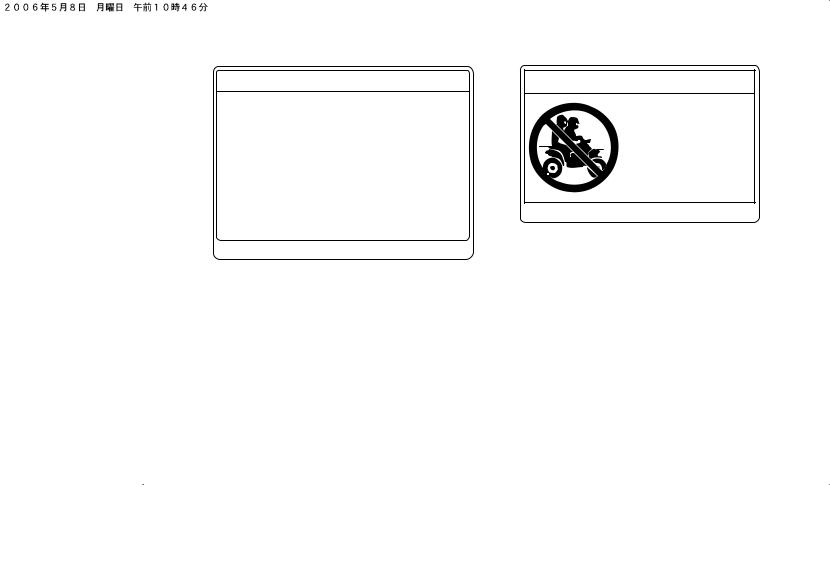
|
3 |
q WARNING |
|
4 |
q WARNING |
||||
2 |
|
||||||||
|
|
|
|||||||
|
IMPROPER TIRE PRESSURE OR OVERLOADING CAN |
|
|
NEVER ride as a |
|||||
|
|
|
|||||||
|
CAUSE LOSS OF CONTROL. |
|
|
|
|
|
|||
|
LOSS OF CONTROL CAN RESULT IN SEVERE |
|
|
|
passenger. |
||||
|
INJURY OR DEATH. |
|
|
|
|
|
|||
|
OPERATING TIRE PRESSURE: Set with tires cold |
|
|
Passengers can cause |
|||||
|
9Recommended : FRONT : 20 |
kPa, {0.20 |
kgf/cm 2 } |
2.9 psi |
|
|
|||
|
9Minimum |
REAR : 20 |
kPa, {0.20 |
kgf/cm 2 } |
2.9 psi |
|
|
a loss of control, |
|
|
: FRONT : 17 |
kPa, {0.17 |
kgf/cm 2 } |
2.5 psi |
|
|
resulting in SEVERE |
||
|
|
REAR : 17 |
kPa, {0.17 |
kgf/cm 2 } |
2.5 psi |
|
|
||
|
9Never set tire pressure below minimum. |
|
|
|
INJURY or DEATH. |
||||
|
It could cause the tire to dislodge from the rim. |
|
|
|
|
|
|||
|
LOADING |
|
|
|
|
|
|
|
|
|
|
|
|
|
|
|
5FE5FE-2151H-2151H-01-01 |
||
|
9Maximum Vehicle Load : 40 kg, (88 lbs). |
|
|
|
|
|
|||
|
|
|
|
|
|
||||
|
Includes weight of operator, cargo and accessories. |
|
|
|
|
||||
5YF5YF-2169696- -00-00
2-4
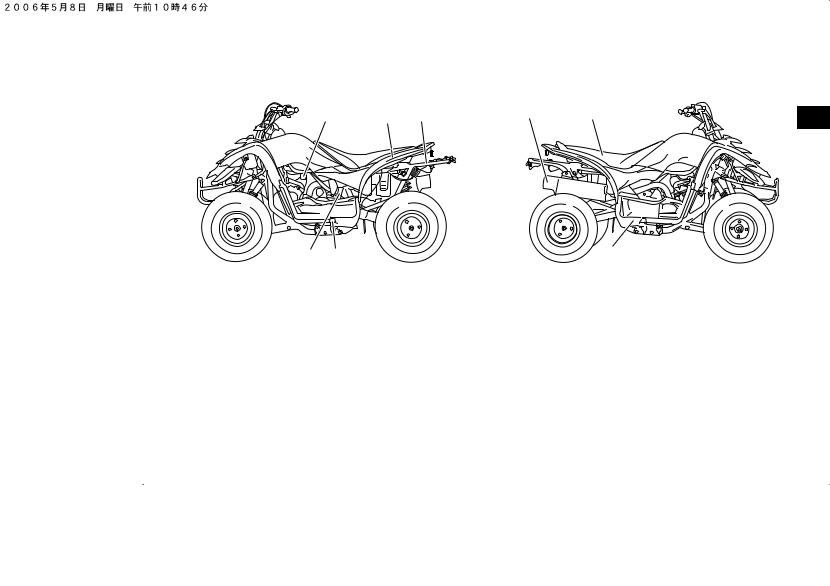
EBU17680
DESCRIPTION
EBU17690 |
|
|
EBU17700 |
|
|
Left view |
|
|
Right view |
|
|
1 |
2 |
3 |
1 |
2 |
3 |
|
5 |
4 |
|
3 |
1. |
Fuel cock |
|
1. |
Spark arrester |
2. |
Fuse |
|
2. |
Seat |
3. |
Engine stop switch with cord (lanyard) |
3. |
Footboard |
|
4.Footboard
5.Drive select lever
3-1
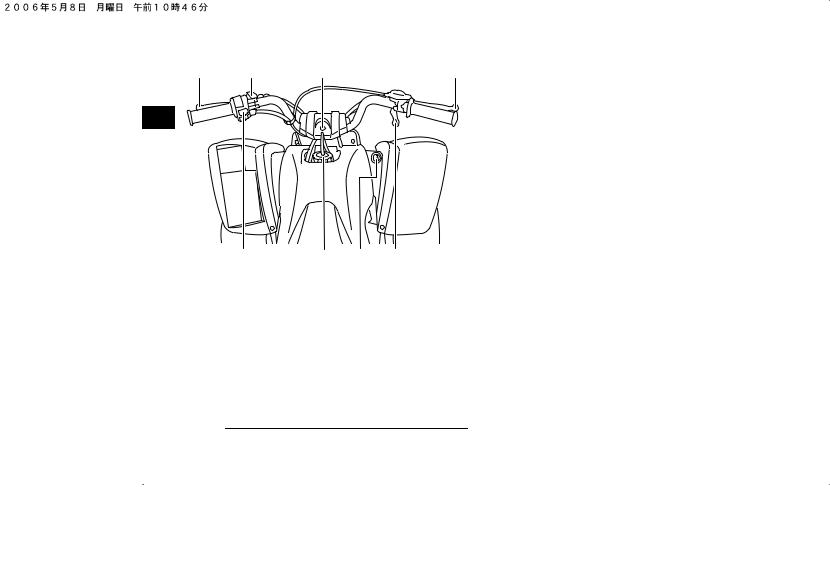
EBU17712 |
|
|
|
from the figures shown in this manual. |
Controls and instruments |
|
|
||
|
|
|||
1 |
2 |
3 |
4 |
|
3
8 |
7 |
6 |
5 |
1.Rear brake lever
2.Parking brake
3.Neutral indicator light
4.Front brake lever
5.Throttle lever
6.Main switch
7.Fuel tank cap
8.Handlebar switches
NOTE:
The ATV you have purchased may differ slightly
3-2
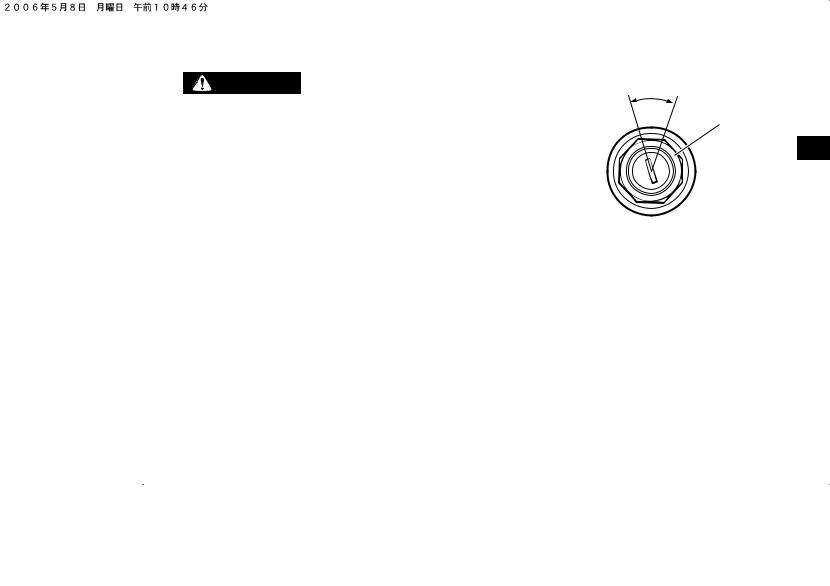
EBU17720
INSTRUMENT AND CONTROL FUNCTIONS
EWB00010
WARNING |
OFF |
ON |
|
Indicates a potential hazard that could result in |
|||
|
|
||
serious injury or death. |
|
1 |
|
EBU17740 |
|
4 |
Main switch
The positions of the main switch are as follows:
ON
All electrical systems are supplied with power, and the engine can be started. The key cannot be removed.
OFF
All electrical systems are off. The key can be removed.
1. Main switch
4-1

EBU17780
Indicator light
4
1
1. Neutral indicator light “N”
EBU17860
Neutral indicator light “ ”
”
This indicator light comes on when the transmission is in the neutral position.
EBU18060
Handlebar switches
12
1.Engine stop switch “ENG. STOP”
2.Start switch “START”
EBU18070
Engine stop switch “ENG. STOP”
Set this switch to “RUN” before starting the engine. The engine stop switch controls the ignition and stops the engine when it is running. Use this switch to stop the engine in an emergency situation. The engine will not start or run when this switch is set to “OFF”.
4-2

EBU18090 |
|
|
Start switch “START” |
|
|
Push this switch to crank the engine with the start- |
|
|
er. |
|
|
ECB00050 |
|
|
CAUTION: |
|
|
See the starting instructions on page 6-1 prior |
|
|
to starting the engine. |
4 |
|
|
||
EBU18260 |
1 |
|
3 2 |
||
Engine stop switch with lanyard |
The clip must be attached to the engine stop switch for the engine to run.
1.Engine stop switch
2.Clip
3.Lanyard
The lanyard should be held by putting your fingers in the loop as shown.
4-3

4 |
1 |
1. Lanyard
Should the ATV be separated from the parent by a distance longer than the lanyard length, the lanyard will pull out the clip and stop the engine.
1
1. Lanyard
For further explanation of this switch and the lanyard, see “TEACHING YOUR CHILD TO OPERATE THE ATV” in the “SAFETY INFORMATION” section.
NOTE:
●The engine cannot be started with the clip removed.
●When your child has developed sufficient skill to no longer need you to follow with the lanyard, the lanyard can be stowed under the seat of the ATV. However, you must still closely supervise your child at all times during ATV operation.
4-4
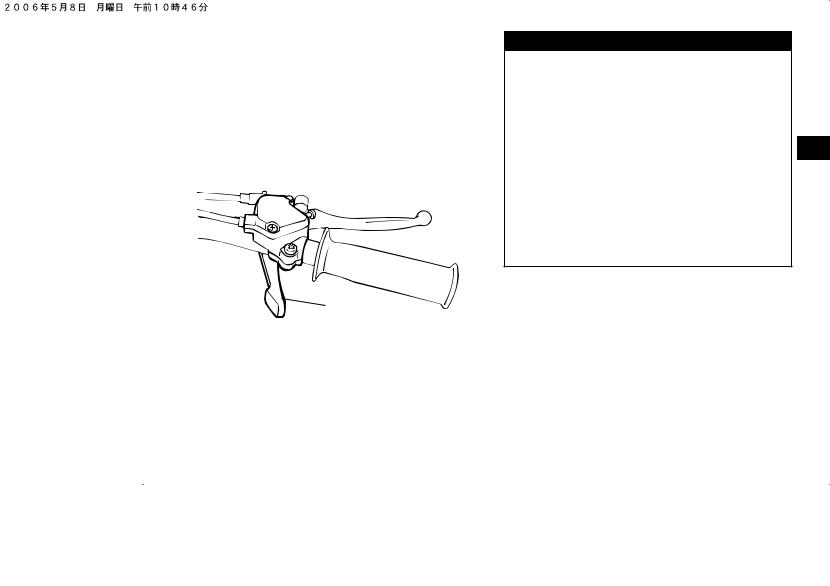
EBU18270
Throttle lever
Once the engine is running, movement of the throttle lever will increase the engine speed.
Regulate the speed of the ATV by varying the throttle position. Because the throttle is springloaded, the ATV will decelerate, and the engine will return to an idle any time the hand is removed from the throttle lever.
1
1. Throttle lever
Before starting the engine, check the throttle to be sure it is operating smoothly. Make sure it returns to the idle position as soon as the lever is released.
EWB00200
 WARNING
WARNING
POTENTIAL HAZARD Malfunction of throttle. WHAT CAN HAPPEN
The throttle could be hard to operate, making it difficult to speed up or slow down when
you need to. This could cause an accident.
4
HOW TO AVOID THE HAZARD
Check the operation of the throttle lever before you start the engine. If it does not work smoothly, check for the cause. Correct the problem before riding the ATV. Consult a Yamaha dealer if you can’t find or solve the problem yourself.
EBU18351
Speed limiter
Your ATV was delivered with an adjustable speed limiter. Yamaha recommends that all beginning riders start off with the speed limiter adjusting screw fully turned in to limit the amount of speed available while they learn.
The speed limiter keeps the throttle from fully opening, even when the throttle lever is pushed to the maximum. The adjusting screw may be gradu-
4-5
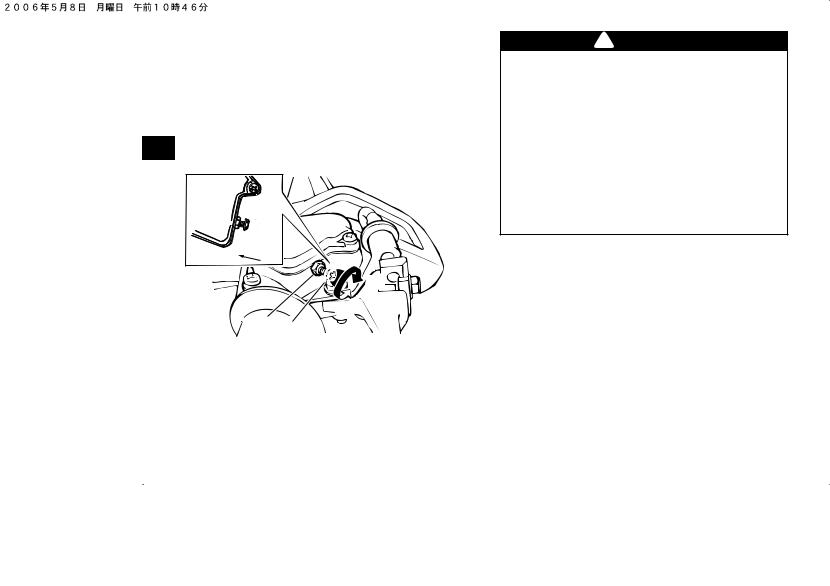
ally turned out as the beginner becomes more familiar with operating the ATV.
1.Loosen the locknut.
2.To increase the maximum engine power available and the maximum speed of the ATV, turn the adjusting screw in direction (a). To decrease the maximum engine power available and the maximum speed of the ATV, turn the
4
adjusting screw in direction (b).

 3
3


 (b)
(b)
(a)
1 2
1.Adjusting screw
2.Locknut
3.No more than 12 mm (0.47 in)
3.Tighten the locknut.
EWB00180
 WARNING
WARNING
POTENTIAL HAZARD
Improper adjustment of the speed limiter and throttle.
WHAT CAN HAPPEN
The throttle cable could be damaged. Improper throttle operation could result. The child could lose control, have an accident or be injured.
HOW TO AVOID THE HAZARD
Do not turn the adjusting screw out more than 12 mm (0.47 in).
EBU18391
Front brake lever
The front brake lever is located on the right handlebar. To apply the front brake, pull the brake lever toward the handlebar grip.
4-6
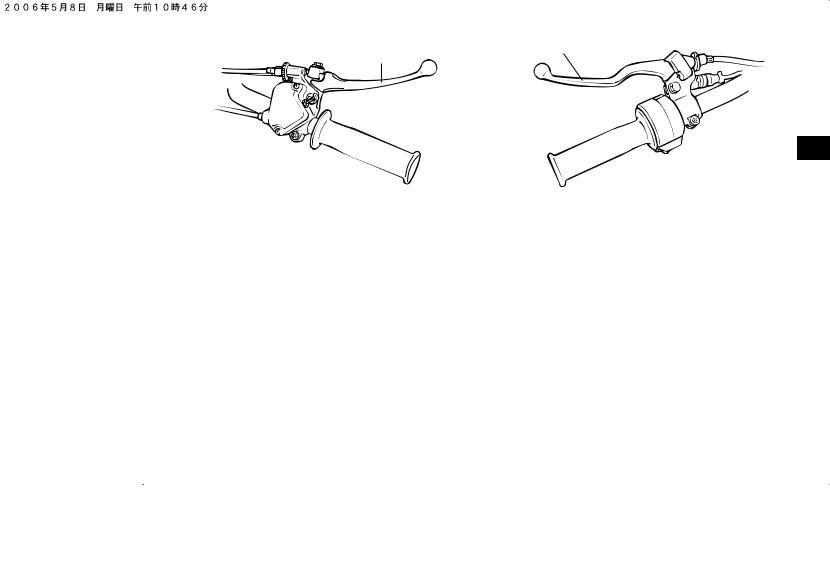
1
1
1. Front brake lever
EBU18401
Rear brake lever
The rear brake lever is located on the left handlebar. To apply the rear brake, pull the brake lever toward the handlebar grip.
4
1. Rear brake lever
EBU18450
Parking brake
Use the parking brake before starting the engine or parking the ATV, especially on a slope. Apply the rear brake lever and push down the lock plate to apply the parking brake. Squeeze the rear brake lever to release the parking brake.
4-7
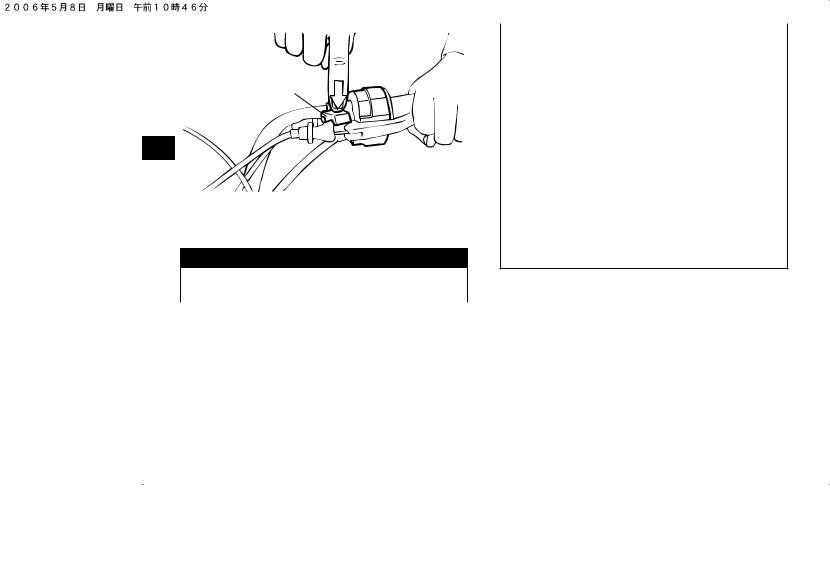
1
4
1. Parking brake lock plate
EWB00170
 WARNING
WARNING
POTENTIAL HAZARD
Improper use of the parking brake.
WHAT CAN HAPPEN
The ATV could start moving unexpectedly if the parking brake is not applied before starting the engine. This could cause loss of control or a collision.
The brake could overheat if you ride the ATV without releasing the parking brake. You could lose braking performance which could cause an accident. You could also wear out the brakes prematurely.
HOW TO AVOID THE HAZARD
Always set the parking brake before starting the engine.
Always be sure you have released the parking brake before you begin to ride.
EBU18630
Drive select lever
The drive select lever is located on the left side of the engine. Use the drive select lever to shift the transmission into drive or neutral.
4-8
